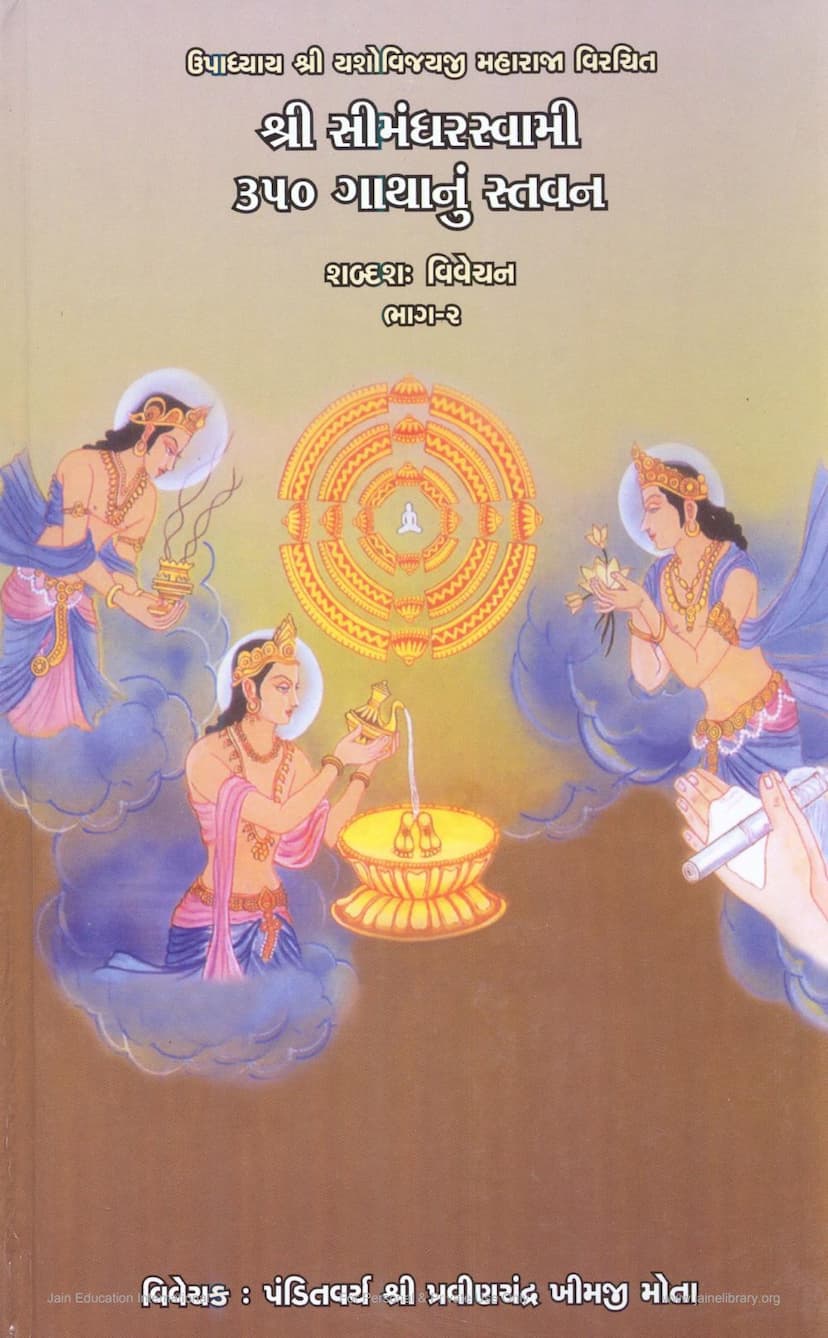Simandhar Swami 350 Gathanu Stavan Part 02
Added to library: September 2, 2025

Summary
This document is the second part of a detailed commentary in Gujarati on a Jain devotional hymn (Stavan) dedicated to Lord Simandhar Swami, composed of 350 verses (Gatha). The book is titled "Shri Simandhar Swami nu 350 Gatha nu Stavan Bhag 02 - Shabdashah Vivechan" and the commentary is by Pandit Shrimad Pravinchandra Khimji Mota.
Here's a summary of the key aspects and content covered in the provided pages:
-
Book Information:
- Title: Shri Simandhar Swami nu 350 Gatha nu Stavan Bhag 02 (Commentary word-by-word)
- Author of Commentary: Pandit Shrimad Pravinchandra Khimji Mota
- Original Composer of the Stavan: Laghu Haribhadra Suri Mahamahopadhyaya Shrimad Yashovijayji Maharaj
- Publisher: Gitarth Ganga, Ahmedabad
- Date of Publication: Veer Samvat 2535 / Vikram Samvat 2065 (July 5, 2009)
- Purpose: To provide a detailed, word-by-word explanation to aid the Jain community in understanding the profound teachings within the hymn.
- Foreword/Editorial Note: Highlights the objective of Gitarth Ganga to analyze Jain scriptures and acknowledges the contributions of revered Acharyas and scholars. It also mentions the demand from the community for such detailed explanations.
-
Content Summary (Based on the "Sankalan" and "Dhal" descriptions): The commentary covers verses (Dhals) 9 to 17 of the 350 Gatha Stavan. The content delves into various aspects of Jain philosophy and practice:
- Dhal 9: Critiques the viewpoint of "Sthanakvasi" Jains who accept the original scriptural verses (Sutras) but reject commentaries (Niryuktis, Bhashyas) and the worship of idols. It argues for the authority of commentaries and the necessity of following established interpretations. It discusses how adhering only to the literal meaning of sutras without understanding the deeper intent leads to misunderstandings and disputes, using examples of apparent contradictions in scriptures that are resolved by commentaries. The importance of understanding the context, purpose, and intent behind scriptures is emphasized.
- Dhal 10: Focuses on the importance of knowledge (Gyan) in performing religious actions. It explains that actions performed without proper understanding and intention (Pranidhan) lead to karmic bondage rather than spiritual liberation. It details various defects in actions arising from ignorance, such as performing rituals without proper understanding of their purpose, acting solely for public recognition, having wrong intentions, or lacking consistent effort. It also describes the eight defects in actions. The importance of the "21 qualities" for practicing true Dharma and the path to becoming a "Bhava Shravak" (ideal lay follower) and "Bhava Sadhu" (ideal renunciate) is discussed.
- Dhal 11: Elaborates on the "21 qualities" required for spiritual progress and to qualify for practicing Dharma. It details each of these qualities, providing a framework for personal spiritual development. The importance of a balanced approach in spiritual practice is highlighted.
- Dhal 12: Focuses on the characteristics of a "Bhava Shravak" (an ideal lay follower). It describes six key qualities of a Bhava Shravak, which include adhering to vows, righteousness, virtues, proper conduct, devotion to gurus, and expertise in scriptures. It further details specific aspects like understanding the vows, proper conduct in worldly affairs, service to the guru, and correct scriptural understanding.
- Dhal 13: Delves into the seventeen inner states or attitudes (Bhavas) of a "Bhava Shravak" that lead to spiritual refinement. These include detachment from the body, senses, wealth, worldly life, and the cultivation of virtues like compassion, non-violence, and equanimity.
- Dhal 14: Explains the seven characteristics of a "Bhava Sadhu" (ideal renunciate). These include adhering to scriptural paths, strong faith, proper conduct, consistent vigilance, controlled desires, virtuous actions, and devotion to the guru.
- Dhal 15: Expounds on the qualities of a "Bhava Sadhu" further, illustrating the depth of their spiritual attainment and their detachment from worldly affairs. It contrasts the conduct of true monks with those who merely wear the monk's robes but lack genuine spiritual understanding or practice. It emphasizes the importance of knowledge and the path to liberation over mere outward austerity.
- Dhal 16: Focuses on the concept of "Nischay Naya" (ultimate truth) and "Vyavahar Naya" (conventional truth) in the context of spiritual progress. It explains how both perspectives are essential for understanding the soul's journey and how focusing solely on one can lead to misunderstanding. It discusses the soul's true nature as pure consciousness, distinct from physical and karmic conditions. It clarifies that the states of existence (like the 14 Gunasthanas) are not the soul's inherent nature but rather its journey through different conditions.
- Dhal 17: Concludes the commentary with a devotional plea to Lord Simandhar Swami. The author expresses gratitude for the spiritual guidance received and reiterates the importance of devotion and adherence to the Lord's teachings for ultimate liberation.
-
Key Themes:
- Importance of Scriptural Study and Commentary: The book strongly advocates for understanding the scriptures through detailed commentaries, as literal interpretations can be misleading.
- Distinguishing True Practice from Superficiality: A significant portion criticizes those who engage in religious rituals without true knowledge, proper intention, or adherence to the spirit of the teachings, contrasting them with genuine spiritual practitioners.
- Path to Liberation: The text outlines the spiritual journey, from the stages of a devoted lay follower (Bhava Shravak) to the ideal renunciate (Bhava Sadhu), emphasizing the internal transformation and cultivation of virtues.
- Role of Knowledge (Gyan): The commentary consistently highlights that knowledge is paramount for correct spiritual practice. Actions without knowledge lead to karmic bondage, while knowledge illuminates the path to liberation.
- Devotion to Simandhar Swami: The hymn and its commentary are infused with deep devotion and reverence for Lord Simandhar Swami, presented as a guide on the spiritual path.
In essence, this volume is a scholarly and devotional work that aims to provide profound insights into Jain philosophy and practice through a detailed explanation of a hymn dedicated to Lord Simandhar Swami. It serves as a guide for seekers to understand the essence of Jainism, the path of liberation, and the qualities of true spiritual practitioners.